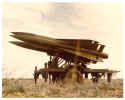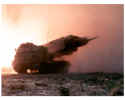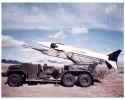1982
FY 82 The State of Alabama permitted the arsenal to establish a sanitary landfill as part of the installation's environmental program. A Groundwater Monitoring Program, mandated by the Resources Conservation and Recovery Act, was also started to determine groundwater characteristics and identify potential pollution sources.
FY 82 EPA listed the DDT contamination of the Wheeler National Wildlife Refuge near Triana, Alabama, as one of the nation's worst hazardous waste sites and a candidate for cleanup money from a $1.6 billion Superfund, a cleanup activity financed largely through taxes on chemical manufacturers. EPA reported that financing for the Redstone Arsenal DDT cleanup was being pursued on three fronts: the Superfund, other federal agencies, and the government lawsuit against the Olin Chemical Corporation. The estimated cost of cleaning up the contaminated land and water adjacent to Redstone Arsenal was about $90 million.
FY 82 Construction began on a $2.9 million solid waste incinerator that would burn trash to produce steam for heating.
FY 82 Construction was completed on the 550-person barracks complex for the bachelor housing program.
FY 82 The Vice Chief of Staff of the Army (VCSA) decided to retain the HAWK system in the Army inventory indefinitely. That the system was still alive and thriving after 25 years was an accomplishment in itself. The Improved HAWK system, the configuration that began to replace the Basic HAWK in 1972, was being upgraded through a series of PIPs to improve reliability, availability, and maintainability (RAM) and to meet the advancing threat.

FY 82 Retrograde of the REDEYE missile systems from Europe commenced during the year concurrently with the phased development of the STINGER weapon system. The REDEYE systems were returned to CONUS for redistribution.

FY 82 Japan became the first allied nation to purchase the STINGER weapon system.
FY 82 STINGER's suitability for use on board ships was certified by German tests completed during the year.
FY 82-83 DOD internal and contract audit activities cited glaring cases of abuse in the pricing of spare parts.
1 January 82 Effective this date, command and control of the 95th Service Company (Calibration and Repair Support) was transferred from the Special Troops Branch to the USATSG. This transfer gave the group's Commander the needed flexibility for maximizing the use of company resources for worldwide TMDE support. It also allowed the effective implementation of the approved DA Improved Concept for TMDE Calibration and Repair Support at FORSCOM and TRADOC Field Calibration Activities.
11 January 82 The DARCOM Deputy Commander for Materiel Readiness decided that system management readiness functions and logistics support responsibility for thermal imagery fire control systems used with guided missile weaponry, along with associated maintenance facilities and TMDE, would be transferred to MICOM from the Electronics Research and Development Command (ERADCOM) and the Communications-Electronics Command (CECOM).
1 February 82 The Army Missile Laboratory received the 1981 DA "Best Laboratory of the Year" award in competition with 35 other labs.
10 February 82 The first full-load launch of MLRS (12 rockets) inflicted heavy damage to a target array located nearly 10 miles from the launcher.

17 February 82 A propellant manufacturing explosion blew a hole through the roof of an arsenal building occupied by the Thiokol Chemical Company. Three Thiokol workers received minor injuries. The explosion shook area buildings, while the Facilities Engineering headquarters building just outside the Thiokol area's fence briefly lost electrical power.
25 February 82 Martin Marietta received a contract for the initial production of HELLFIRE laser seekers.
March 82 The MLC Maintenance Engineering Directorate assumed the logistics support function for the strategic SENTRY missile system being deployed by the U.S. Army Ballistic Missile Defense Systems Command in Huntsville, Alabama. The SENTRY was designed to help defend the U.S. land-based intercontinental ballistic missile (ICBM) force by intercepting incoming enemy warheads within the atmosphere during the last ten seconds of flight.
March 82 MICOM awarded Hughes Aircraft a contract for the full-scale engineering development effort to integrate the TOW 2 with the BFVS.
1 March 82 In keeping with the thrust of the Defense Acquisition Improvement Program (DAIP), also known as the Carlucci initiatives, the MICOM Commander appointed Ernest A. Young as the MICOM Special Advocate for Competition (SAC). A Special Committee for Competition (SCC) was also formed effective 1 April 82. The ultimate objective of the SAC/SCC was to increase the number of potential sources for competition and reduce the number of sole source contracts.
10 March 82 MICOM issued letter order modifications to the Hughes Aircraft Company and the Boeing Aerospace Company to adjust the existing contracts to meet reduced U.S. ROLAND production requirements.
29 March 82 HELLFIRE was approved for full-scale production.
31 March 82 Vought was awarded a concept definition contract to begin development of a binary chemical warhead (BCW). The BCW would be a retaliatory weapon with a medium range, high volume of fire, and wide area coverage. It would force enemy troops to mask, don protective gear, or restrict themselves to protective structures thereby reducing the enemy's ability to move, maneuver, and fight.
April 82 DA stopped the SHILLELAGH phasedown effort pending review of an alternate use for the SHERIDAN/SHILLELAGH systems.
April 82 Ford Aerospace and Communications Corporation (FACC) delivered a prototype Towed CHAPARRAL to the Yakima Firing Center, Washington, for demonstration and evaluation. The 9th ID successfully fired four missiles from the towed launcher.
27 April 82 MICOM lost a significant mission when USATSG became a tenant activity reporting directly to the DARCOM Deputy Commanding General (DCG) for Materiel Readiness, who had been designated the Executive Director for TMDE effective this date.
27-28 April 82 MICOM conducted technical feasibility demonstrations at McGregor Range, Fort Bliss, Texas, in which unmodified Basic STINGER missiles were fired from the M55 multiround STINGER launcher (MUSL) test bed. The firing on 28 April represented a significant milestone since it was the first night launch of a STINGER missile.
30 April 82 Rockwell International Corporation received a contract for the development and qualification of a minimum smoke motor to eliminate the firing signature of the HELLFIRE missile, thereby increasing system survivability.
21 May 82 The Army's first PATRIOT missile battery-the 1st Battalion, 43d Air Defense Artillery (ADA)-was activated at Fort Bliss, Texas.
June 82 Tactical troops from USAREUR successfully fired STINGER for the first time in a field setting.

June 82 DA approved a required operational capability (ROC) document for ATAS to be installed on all-weather, day-night aircraft developed under the Army Helicopter Improvement Program (AHIP).
7 June 82 The Thermal Imagery Systems Management Office was established provisionally as a separate element of MLC. The office was permanently organized effective 1 October 82 to perform complete Level II project management functions for all missile-related thermal imagery programs.
21 June 82 MICOM established an award-known as the Toftoy Readiness Award-to recognize Army units that maintained superior missile materiel readiness ratings. The award was named for MG Holger N. Toftoy, who supervised the development of the Army's first operational guided missiles while serving as Director of the Ordnance Missile Laboratories. He commanded Redstone Arsenal from 1 September 54 to March 58.
30 June 82 The Under Secretary of Defense for Research and Engineering directed that the Army and Air Force pool the separate technologies developed under the Army's CSWS program and the Air Force's Conventional Standoff Weapon (CSW) program to form the Joint Tactical Missile System (JTACMS). The similarity of the Army and Air Force operational needs for a missile to attack second echelon and deep interdiction targets suggested the economy of a coordinated approach to develop a common system.
July 82 Redstone Arsenal began to monitor the passive drainage system which replaced the water treatment plant built by the Calgon Corporation to filter water draining off the old DDT manufacturing site. The Army decided to replace the Calgon system, which had been in operation since January 79, because of the high cost and questionable effectiveness of the filtering apparatus. The new monitoring program indicated that the installation was maintaining a zero-discharge condition.
July 82 The engineering development contract was awarded for the modification of the HELLFIRE autopilot to improve the missile's capability in low visibility conditions. This effort was designed to cause the missile to fly a more direct trajectory from the launch aircraft to the target during periods of adequate horizontal visibility and low ceiling.
1 July 82 DARCOM-Europe was activated at Seckenheim, Germany. Concurrently, MICOM maintenance activities in Europe were among the first to come under the new DARCOM-Forward concept. Effective this same date, DESCOM's Mainz Army depot assumed operational control of the Pirmasens Missile Repair Activity, Fischstein PERSHING In-Theater Repair Program, and HAWK Field Facility-Europe at Manheim. The formal transfer of command occurred on 1 October 82.
1 July 82 The White House announced that about 60,000 acres of surplus federal property would be offered for public sale to help reduce the national debt. No date for the sale was given, but 60 acres of land at Redstone Arsenal was among the acreage slated for auction. The arsenal land to be sold was in three tracts near the Alabama Space and Rocket Center. This sale would reduce the installation's total land area from 38,309 to 38,249 acres.
9 July 82 The MICOM Commander approved a type classification of obsolete for all HONEST JOHN rocket motors, launchers, and related ground equipment items.

15 July 82 Responsibility for the Joint Anti-Tactical Missile (JATM) program was first assigned to MICOM. At the same time, the JATM Program Office was established provisionally. Previously, on 4 June 82, the Principal Deputy Under Secretary of Defense for Research and Engineering, had directed that a joint service program be started addressing a defense against tactical missiles. After DA was assigned to take the lead as the Executive Service for the program, the VCSA selected MICOM to be the lead Army element.
16 July 82 MICOM extended the REDEYE's shelf life from 18 to 20 years.
29 July 82 An MOU supplement authorizing Italy's participation in the MLRS program was signed by all cooperating nations.
25 August 82 To bring federal employment and payroll within specified year-end limits, MICOM notified 35 civilian workers that they would be furloughed for 31 days beginning 25 September 82. These workers were chosen because they had the least federal service. Another 46 temporary employees were given a choice of being terminated or placed on leave without pay for 31 days. Shortly before the furlough was to begin, however, MICOM cancelled it. Action concerning the temporary workers was implemented as scheduled.
September 82 The MLC Director issued instructions for the organization of logistics support teams for each weapon system managed or supported by MICOM, in either fielded or pre-deployment status. The teams would systematically address those non-routine or long-term logistics issues and problem areas requiring the coordinated efforts of more than one MLC POE to resolve.
September 82 FACC received a contract for the development of a rosette scan seeker (RSS) guidance section, which would result in an MIM-72G missile for the CHAPARRAL air defense system.
September 82 DA established the RATTLER-06 Working Group to expedite planning, respond to the Under Secretary of the Army's concerns about the RATTLER requirement and affordability, and present an acquisition strategy for approval.
27 September 82 The first FMS case for the MLRS was submitted to the U.S. Army Security Assistance Center (USASAC). The case, valued at $15.1 million, was for the United Kingdom.
30 September 82 Once negotiations were completed, Redstone Arsenal was issued a National Pollutant Discharge Elimination System permit on this date.
30 September 82 RASA allowed the Calgon Carbon Absorption Water Treatment Plant contract to expire on this date. However, the State of Alabama reserved the right to require future treatment if water conditions indicated that it was necessary.
16 October 82 Occupancy of a new barracks complex on Aerobee Road began. The $7 million complex could house up to 720 soldiers. It consisted of four 3-story buildings with 240 bedrooms, 60 living rooms, and 4 day rooms. The facility was used to billet student personnel assigned to the 4th, 6th, 7th, and 8th Student Companies of MMCS.
19 October 82 MICOM disseminated the final NIKE HERCULES system support buyout (SSBO) package to users. The command received about 4000 requisitions from allied countries between 31 March 84 and 31 August 84 to support SSBO and post-1985 supply requirements.
December 82 MICOM issued its policy on competitive procurement planning this month. It required all systems managers to develop an acquisition strategy early in the system acquisition cycle that would result in the most economical system capable of meeting the needs of the user and being fielded at the earliest practical date.
Redstone Arsenal Era:
Intro,
1980,
1981,
1982,
1983,
1984,
1985,
1986,
1987,
1988,
1989
